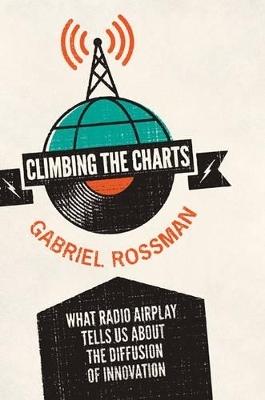
Climbing the Charts
Princeton University Press (Verlag)
978-0-691-14873-1 (ISBN)
Despite the growth of digital media, traditional FM radio airplay still remains the essential way for musicians to achieve commercial success. Climbing the Charts examines how songs rise, or fail to rise, up the radio airplay charts. Looking at the relationships between record labels, tastemakers, and the public, Gabriel Rossman develops a clear picture of the roles of key players and the gatekeeping mechanisms in the commercial music industry. Along the way, he explores its massive inequalities, debunks many popular misconceptions about radio stations' abilities to dictate hits, and shows how a song diffuses throughout the nation to become a massive success. Contrary to the common belief that Clear Channel sees every sparrow that falls, Rossman demonstrates that corporate radio chains neither micromanage the routine decision of when to start playing a new single nor make top-down decisions to blacklist such politically inconvenient artists as the Dixie Chicks. Neither do stations imitate either ordinary peers or the so-called kingmaker radio stations who are wrongly believed to be able to make or break a single.
Instead, Rossman shows that hits spread rapidly across radio because they clearly conform to an identifiable style or genre. Radio stations respond to these songs, and major labels put their money behind them through extensive marketing and promotion efforts, including the illegal yet time-honored practice of payoffs known within the industry as payola. Climbing the Charts provides a fresh take on the music industry and a model for understanding the diffusion of innovation.
Gabriel Rossman is assistant professor of sociology at the University of California, Los Angeles.
List of Figures vii Acknowledgments ix 1 Introduction 1 1.1 The Diffusion of Innovation 2 1.2 The Production of Culture 6 1.3 Organization of the Book 8 2 How Songs Spread 11 2.1 Record Release Dates 12 2.2 Corporate Radio 15 3 Buying Your Way onto the Chart 22 3.1 A History of Payola Scandals 24 3.1.1 The 1950s Scandal and the Rise of Rock and Roll 25 3.1.2 The 1973 Drugola Scandal 27 3.1.3 The Gambino Family and "The Network" in the 1980s 28 3.1.4 Corporate Radio, Professionalized Payola, and the 2005 Spitzer Investigation 30 3.2 Suppressing Payola 35 3.2.1 The Robust Logic of Payola 39 4 Can Radio Stations Break Singles? 44 4.1 The Role of "Opinion Leaders" in Diffusion 45 4.2 The Distribution of Connection in Radio 48 4.3 Diffusion of Pop Songs and Radio Stations 51 4.4 The Role of Influentials for Endogenous Diffusion 53 5 The Dixie Chicks Radio Boycott 59 5.1 Corporate Censorship 60 5.2 Social Movements 63 5.3 Genre 67 6 But Which Chart Do You Climb? 71 6.1 Trends in the Differentiation of Radio Formats 72 6.2 Classification and Art 75 6.3 Crossover 77 6.4 New Genres and Formats 80 6.4.1 Reggaeton Comes to the Mainland 81 6.4.2 The Development of the "Hurban" Format as an Artistic and Market Niche 83 7 The Future of the Chart 91 7.1 General Lessons of the Book for Diffusion of Innovations 95 7.1.1 Particular Lessons for Diffusion in Pop Music Radio 98 7.2 Centralization and Distribution of Decision-making 100 7.3 The Struggle to Control Publicity 108 7.4 Structures of Salient Information 112 7.5 Genre 116 7.6 The Emerging Structure of Popular Culture Industries in the Twenty-first Century 119 Appendix A Datasets 123 Appendix B Robustness to Assumptions about Volume of Airplay Constituting an "Add" 127 Notes 133 Bibliography 155 Index 167 FIGURES 1.1 The Two Ideal Diffusion Curves 3 1.2 The Hirsch Gatekeeping Model 6 2.1 Diffusion Curve for "Umbrella" by Rihanna on Top 40 Stations 12 2.2 Diffusion Curves for Singles on the Rihanna Album Good Girl Gone Bad on Top 40 Stations 13 2.3 Hazards for Singles on the Rihanna Album Good Girl Gone Bad on Top 40 Stations 14 2.4 Illustration of the Corporate "Single Playlist" Hypothesis 17 2.5 Diffusion Curves for "Umbrella" by Rihanna for Top 40 Stations Owned by Various Chains 18 2.6 Distribution of Song Adoption Time Clustering by Corporate Owner 20 3.1 Stories on "Payola" and "Radio" in the New York Times 25 3.2 Exogenous Diffusion Coefficient by Quarter 37 4.1 Distribution of Nominations for Top 40 Stations 49 4.2 Social Network of Top 40 Stations 50 4.3 Typical Adoption Time as a Function of Nominations for Top 40 Stations 52 4.4 Diffusion Curves for Singles on the Black Eyed Peas Album Monkey Business on Top 40 Stations 54 4.5 Top 40 Stations in Social Network Space with Filled Dots for Those Having Played "My Humps" 57 5.1 Daily Spins of Dixie Chicks Songs on Country Stations 60 5.2 Daily Spins of Dixie Chicks Songs on Country Stations by Chain 62 5.3 Daily Spins of Dixie Chicks Songs on Country Stations by 2000 Presidential Vote 66 5.4 Daily Spins of Dixie Chicks Songs by Station Format 69 6.1 Diffusion Curve for "Love Song" by Sara Bareilles in AAA, Hot AC, Mainstream AC, and Top 40 Radio 78 6.2 Diffusion Curve for "Oye Mi Canto" by N.O.R.E., Nina Sky, and Daddy Yankee 82 6.3 Growth in Reggaeton Airplay (with Bootstrapped Confidence Intervals), 2004-2005 84 6.4 Trade Advertisement for the Si TV Cable Channel 87 6.5 Diffusion Curve for "Rompe" by Daddy Yankee on Latin and Hip-Hop Radio 89 B.1 Diffusion Curves for Singles on the Rihanna Album Good Girl Gone Bad on Top 40 Stations with Varying Definitions of an "Add" 128 B.2 Top 40 Stations in Social Network Space with Filled Dots for Those Playing "My Humps" at Least Five Times in the Stated Week 129
| Erscheint lt. Verlag | 22.7.2012 |
|---|---|
| Zusatzinfo | 2 halftones. 26 line illus. 1 table. |
| Verlagsort | New Jersey |
| Sprache | englisch |
| Maße | 152 x 235 mm |
| Gewicht | 454 g |
| Themenwelt | Kunst / Musik / Theater ► Film / TV |
| Kunst / Musik / Theater ► Musik ► Allgemeines / Lexika | |
| Kunst / Musik / Theater ► Musik ► Pop / Rock | |
| Sozialwissenschaften ► Kommunikation / Medien ► Medienwissenschaft | |
| Sozialwissenschaften ► Soziologie | |
| ISBN-10 | 0-691-14873-2 / 0691148732 |
| ISBN-13 | 978-0-691-14873-1 / 9780691148731 |
| Zustand | Neuware |
| Haben Sie eine Frage zum Produkt? |
aus dem Bereich


